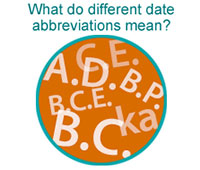TUTORIAL
Learn About Archaeology
Archaeological Dating
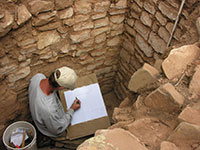 Without the ability to date archaeological sites and specific contexts within them, archaeologists would be unable to study cultural change and continuity over time. No wonder, then, that so much effort has been devoted to developing increasingly sophisticated and precise methods for determining when events happened in the past.
Without the ability to date archaeological sites and specific contexts within them, archaeologists would be unable to study cultural change and continuity over time. No wonder, then, that so much effort has been devoted to developing increasingly sophisticated and precise methods for determining when events happened in the past.
In archaeology, dating techniques fall into two broad categories: chronometric (sometimes called “absolute”) and relative.
Chronometric dating techniques produce a specific chronological date or date range for some event in the past. For example, the results of dendrochronology (tree-ring) analysis may tell us that a particular roof beam was from a tree chopped down in A.D. 1262.
Relative dating techniques, on the other hand, provide only the relative order in which events took place. For example, the stratum, or layer, in which an artifact is found in an ancient structure may make it clear that the artifact was deposited sometime after people stopped living in the structure but before the roof collapsed. However, the stratigraphic position alone cannot tell us the exact date.
What do different date abbreviations mean?
A.D. (Anno Domini, year of the Lord) and B.C. (Before Christ) have long been used by archaeologists in Europe and the Americas; their reference point is the birth of Christ.
C.E. (Current Era) and B.C.E. (Before Current Era) are sometimes used instead of A.D. and B.C. as a way to express a date without specifically referencing Christianity. But the dates themselves are exactly comparable to dates expressed as A.D. or B.C. For example, 1280 C.E. is the same year as A.D. 1280, and 228 B.C.E. is the same year as 228 B.C.
B.P. (Before the Present) is the number of years before the present. Because the present changes every year, archaeologists, by convention, use A.D. 1950 as their reference. So, 2000 B.P. is the equivalent of 50 B.C.
ka (kilo annum, thousand years) signifies “thousand calendar years ago,” and it is used most often in geological, paleontological, and archaeological reporting to assign a general date to events that occurred a very long time ago. For example, the entry of humans into the New World during the Pleistocene (Ice Age) is thought to have occurred by about 15,000 years ago, or 15 ka (which is equivalent to approximately 13,000 B.C).
Dendrochronology
This chronometric technique is the most precise dating tool available to archaeologists who work in areas where trees are particularly responsive to annual variations in precipitation, such as the American Southwest.
Developed by astronomer A. E. Douglass in the 1920s, dendrochronology—or tree-ring dating—involves matching the pattern of tree rings in archaeological wood samples to the pattern of tree rings in a sequence of overlapping samples extending back thousands of years. These cross-dated sequences, called chronologies, vary from one part of the world to the next. In the American Southwest, the unbroken sequence extends back to 322 B.C.
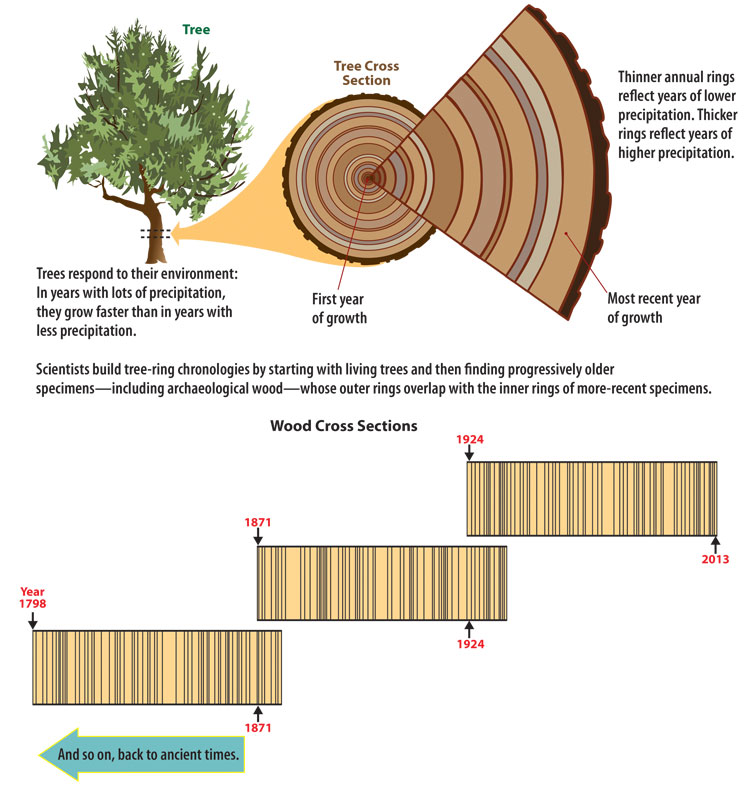 So, when an archaeologist finds a well-preserved piece of wood—say, a roof beam from an ancient pithouse—dendrochronologists prepare a cross section and then match the annual growth rings of the specimen to those in the already-established chronology to determine the year the tree was cut down.
So, when an archaeologist finds a well-preserved piece of wood—say, a roof beam from an ancient pithouse—dendrochronologists prepare a cross section and then match the annual growth rings of the specimen to those in the already-established chronology to determine the year the tree was cut down.
Learn more:
Read how A. E. Douglass pioneered the science of tree rings in this 1929 National Geographic article titled “The Secret of the Southwest Solved by Talkative Tree Rings.” Includes numerous fascinating historic photographs. (Article available on the Indiana State University website.)
The Laboratory of Tree-Ring Research in Tucson is the world’s oldest dendrochronology lab; their website includes information for researchers and the general public.
The Science of Tree Rings is an educational website with lots of information—from basic definitions and principles to links to tree-ring databases and other resources.
Radiocarbon Dating
Every living thing on earth contains the element carbon. When an organism dies, be it a plant or an animal, the carbon acquired during its lifetime begins to decay at a steady, predictable rate, releasing carbon-14, a radioactive isotope with a half-life of 5,730 years. By measuring the amount of carbon-14 left in the organism, scientists can estimate how long ago the organism died. Radiocarbon dates are often reported as a range.
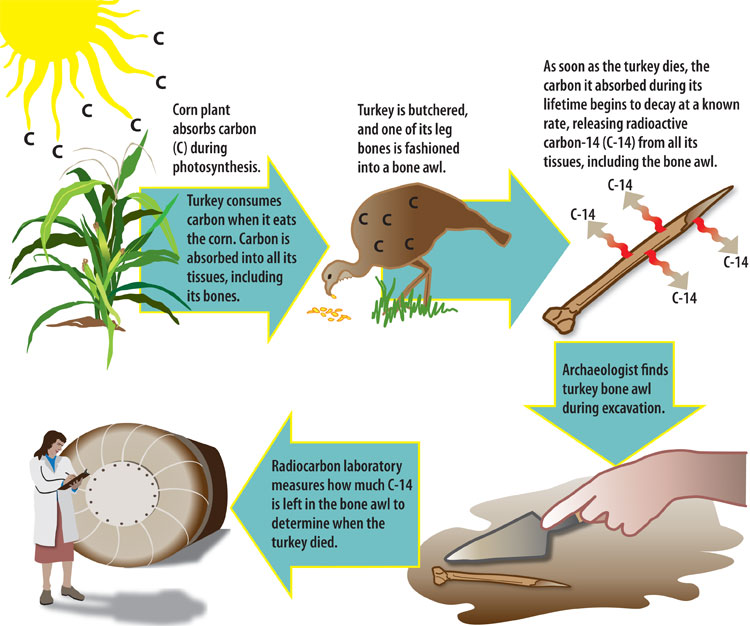 In recent years, scientists have refined methods for radiocarbon dating. Accelerated mass spectrometry, or AMS, is more precise than standard radiocarbon dating and can be performed on smaller samples.
In recent years, scientists have refined methods for radiocarbon dating. Accelerated mass spectrometry, or AMS, is more precise than standard radiocarbon dating and can be performed on smaller samples.
Learn more:
Radiocarbon Dating is an “ArchaeInteractive” module from North Carolina State University.
Archaeomagnetic Dating
Archaeomagnetic dating is a method of dating iron-bearing sediments that have been superheated—for example, the clay lining of an ancient hearth.
Archaeomagnetic dating works because the earth’s magnetic field “wanders,” continually changing its position in response to changes in the flow of liquid iron in the planet’s core.
By tracking and cross-dating past changes in the location of the magnetic field, geophysicists have reconstructed a series of magnetic polar positions extending back more than 2,000 years. This series of dated positions is known as the “archaeomagnetic reference curve.” (Stacey Lengyel, 2010. The Pre–A.D. 585 Extension of the U.S. Southwest Archaeomagnetic Reference Curve. Journal of Archaeological Science 37:3081–3090.)
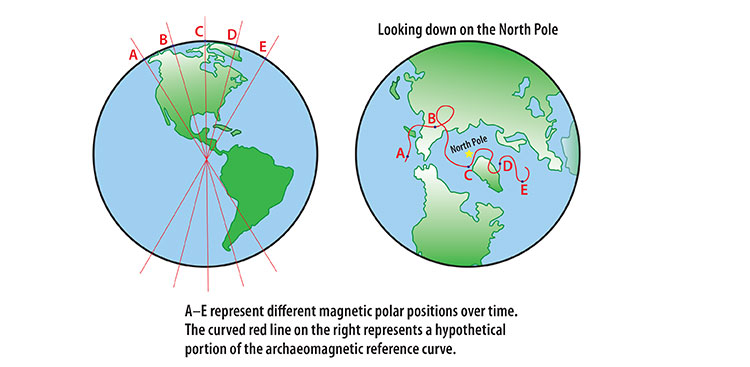 So how do scientists use the earth’s wandering magnetic field to date archaeological sites?
So how do scientists use the earth’s wandering magnetic field to date archaeological sites?
It’s all about clay. Certain clays have a naturally high iron (Fe) content. When these clays are heated to high temperatures, the iron in them aligns with the earth’s magnetic field at that moment. As the clay cools, the alignment of the iron “fixes,” preserving a record of the magnetic field at a specific time in the past.
At archaeological sites, hearths constructed of iron-bearing clays are ideal for archaeolomagnetic sampling because they were subjected to repeated hot firings. The iron in the clay realigned with every sufficiently hot fire, so it is the last hot fire in a hearth that archaeologists are able to date.
 Learn more:
Learn more:
Learn more about earth’s shifting magnetism in Earth’s Inconstant Magnetic Field, a Science News article on NASA’s website.
For more information about archaeomagnetic dating, see Paleomagnetic and Archaeomagnetic Dating on the University of California, Santa Barbara, website.
Archaeomagnetic Dating
Archaeomagnetic dating is a method of dating iron-bearing sediments that have been superheated—for example, the clay lining of an ancient hearth.
Archaeomagnetic dating works because the earth’s magnetic field “wanders,” continually changing its position in response to changes in the flow of liquid iron in the planet’s core.
By tracking and cross-dating past changes in the location of the magnetic field, geophysicists have reconstructed a series of magnetic polar positions extending back more than 2,000 years. This series of dated positions is known as the “archaeomagnetic reference curve.” (Stacey Lengyel, 2010. The Pre–A.D. 585 Extension of the U.S. Southwest Archaeomagnetic Reference Curve. Journal of Archaeological Science 37:3081–3090.)
 So how do scientists use the earth’s wandering magnetic field to date archaeological sites?
So how do scientists use the earth’s wandering magnetic field to date archaeological sites?
It’s all about clay. Certain clays have a naturally high iron (Fe) content. When these clays are heated to high temperatures, the iron in them aligns with the earth’s magnetic field at that moment. As the clay cools, the alignment of the iron “fixes,” preserving a record of the magnetic field at a specific time in the past.
At archaeological sites, hearths constructed of iron-bearing clays are ideal for archaeolomagnetic sampling because they were subjected to repeated hot firings. The iron in the clay realigned with every sufficiently hot fire, so it is the last hot fire in a hearth that archaeologists are able to date.
 Learn more:
Learn more:
Learn more about earth’s shifting magnetism in Earth’s Inconstant Magnetic Field, a Science News article on NASA’s website.
For more information about archaeomagnetic dating, see Paleomagnetic and Archaeomagnetic Dating on the University of California, Santa Barbara, website.
Stratigraphic Dating
Stratigraphy refers to layers of sediment, debris, rock, and other materials that form or accumulate as the result of natural processes, human activity, or both. An individual layer is called a stratum; multiple layers are called strata.
At an archaeological site, strata exposed during excavation can be used to relatively date sequences of events. At the heart of this dating technique is the simple principle of superposition: Upper strata were formed or deposited later than lower strata.
Applying the principle of superposition, we know that Stratum A was deposited after Stratum B, Stratum B was deposited after Stratum C, and so on. Without additional information, however, we cannot assign specific dates or date ranges to the different episodes of deposition. In this example, archaeologists might radiocarbon date the basket fragment or bone awl in Stratum E, and they could use artifact seriation to obtain fairly precise date ranges for Strata A, B, C, and E. If the date on the car license plate is preserved, they can say with certainty that Stratum A was deposited in that year or later.
Artifact Seriation
Seriation refers to the chronological ordering of artifacts of a particular class—but of different styles. The best artifacts are those whose styles changed at a relatively rapid rate and that are found in contexts that can be independently dated using chronometric dating.
Of all the artifacts made by Pueblo farmers in the ancient Southwest, pottery is the most sensitive for purposes of seriation dating. The styles are distinctive and they continually changed over time. Pottery is also abundant in ancient Pueblo sites, and its occurrence in many tree-ring-dated contexts has allowed archaeologists to determine fairly precisely when different styles were made.
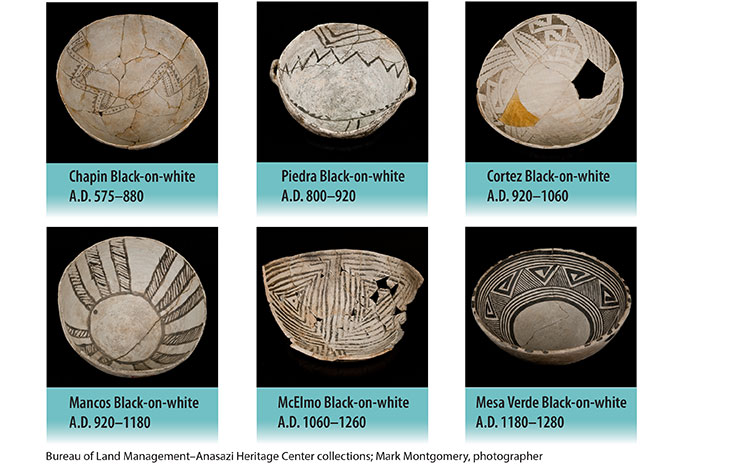 Because the date ranges for various ancient pottery types are so firmly established, archaeologists can use the mere presence of a particular type of pottery to determine the general time period of occupation of a site, even in the absence of other dating evidence.
Because the date ranges for various ancient pottery types are so firmly established, archaeologists can use the mere presence of a particular type of pottery to determine the general time period of occupation of a site, even in the absence of other dating evidence.
Half-Life of Carbon-14
The half-life of a radioactive substance is the length of time it takes for half of the radioactive atoms to decay. For carbon-14, that is 5,730 years:


